Mantle cavity:
The mantle cavity is formed by a fold of the backside of the bodywall (roof) and the head neck and body of the snail (floor). It can be considered as a sac, loosely attached to the inside of the shell and enveloping the head-neck and the gills-lung area of the body.
The mantle cavity is formed by a fold of the backside of the bodywall (roof) and the head neck and body of the snail (floor). It can be considered as a sac, loosely attached to the inside of the shell and enveloping the head-neck and the gills-lung area of the body.
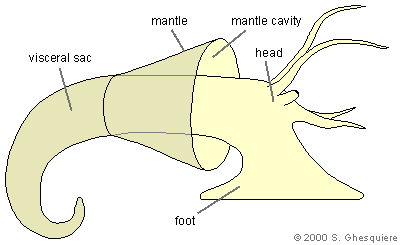 |
The top of the mantle cavity (the part away from the shell opening or the posterior part) is separated in two chambers, the left one forms the lung and right one contains the gill (ctenidium) with the hypobranchial gland in between the rectum and the gill. The latter (hypobranchial gland) secretes mucus into the mantle cavity.
The bottom of the mantle cavity (anterior) is the mantle edge, which fits against the shell opening (aperture) and has an important function: it is the growing edge for the shell.
Besides the gill and the lung, the mantle cavity also contains the penis sheath (in the male snail), female gonopore, rectum, anus and osphradius (smell organ).
The epinaenium is a muscular ridge that starts in the top of the mantle cavity (posterior) and extents across the floor of the mantle (the back of the snail's head) towards the breathing siphon. It's main function is to close the left side were when breating air to prevent an air flow over the gills (right side of the cavity).
The bottom of the mantle cavity (anterior) is the mantle edge, which fits against the shell opening (aperture) and has an important function: it is the growing edge for the shell.
Besides the gill and the lung, the mantle cavity also contains the penis sheath (in the male snail), female gonopore, rectum, anus and osphradius (smell organ).
The epinaenium is a muscular ridge that starts in the top of the mantle cavity (posterior) and extents across the floor of the mantle (the back of the snail's head) towards the breathing siphon. It's main function is to close the left side were when breating air to prevent an air flow over the gills (right side of the cavity).
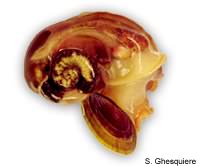 The snail body, taken out of the shell (Pomacea diffusa). | 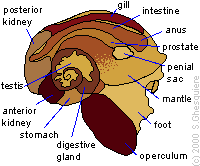 Note: this animal was not killed especially to make this picture. |
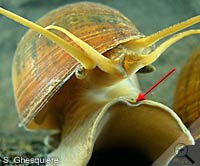 At the front of the foot, there is a cleavage (Pomacea canaliculata). (Click on image to enlarge) | 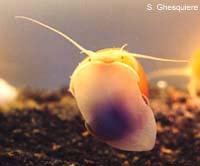 The muscular foot (Pomaceadiffusa). |
Foot:
The muscular foot is used for locomotion and consists of several muscular layers. There are two types of walking in apple snails: with creeping locomotion and with a small wave locomotion.
The creeping locomotion is consists of an extention-contraction (elongation-shortening) movement of the foot. Snails that use this rather rare technique do not move at a constant speed . At least one apple snail species uses this walking method, although not all the time: Asolene spixi. An example of this can be seen in the following MPEG movie: [Asolene_walk] (140kb). This movie plays at 10x speed. Other species use this movement tecnhique when theu burry in the substrate.
A much more common locomotion is used by the majority of the apple snails and is achived by contraction waves on the sole of the foot. The result is a smooth walk with a constant velocity. An example of this can be seen in this MPEG movie of a Pomacea canaliculata snail: [Pomacea_walk] (210kb). Speed of this movie: 3x.
The muscular foot is used for locomotion and consists of several muscular layers. There are two types of walking in apple snails: with creeping locomotion and with a small wave locomotion.
The creeping locomotion is consists of an extention-contraction (elongation-shortening) movement of the foot. Snails that use this rather rare technique do not move at a constant speed . At least one apple snail species uses this walking method, although not all the time: Asolene spixi. An example of this can be seen in the following MPEG movie: [Asolene_walk] (140kb). This movie plays at 10x speed. Other species use this movement tecnhique when theu burry in the substrate.
A much more common locomotion is used by the majority of the apple snails and is achived by contraction waves on the sole of the foot. The result is a smooth walk with a constant velocity. An example of this can be seen in this MPEG movie of a Pomacea canaliculata snail: [Pomacea_walk] (210kb). Speed of this movie: 3x.
| Movies (MPEG1): - Walking apple snail on glass (Asolene spixi) (140kb, 10x) - Walking Pomacea canaliculata (Pomacea canaliculata) (210kb, 3x) |
Because the apple snail has a lung the animal doesn't have to bear all it's weight when moving under water: the animal partly floats on the air in the lung. This declares why such rather big snails can 'walk' fairly elegant across the bottom.
Besides it locomotion function, the foot is also used to collect food from the surface (film-feeding or ciliary feeding). Forming a funnel with the foot in which particles from the surface can be trapped does this. To attract the floating food pieces, the snail makes the same movement with its foot as it does to walk, but only with the front part of the foot and the middle part, forming the funnel. With the tail of the foot, the snail stays attached to the side or an object near the surface.
Once the funnel is filled with food, the snail brings its mouth in the funnel and starts with its meal.
Besides it locomotion function, the foot is also used to collect food from the surface (film-feeding or ciliary feeding). Forming a funnel with the foot in which particles from the surface can be trapped does this. To attract the floating food pieces, the snail makes the same movement with its foot as it does to walk, but only with the front part of the foot and the middle part, forming the funnel. With the tail of the foot, the snail stays attached to the side or an object near the surface.
Once the funnel is filled with food, the snail brings its mouth in the funnel and starts with its meal.
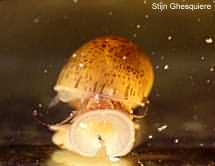 Collecting food from the surface, seen from above (Pomaceacanaliculata, juvenile). | 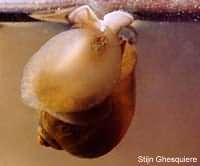 Collecting food from the surface, sideview (Pomacea canaliculata, juvenile). |
No comments:
Post a Comment